
Leucojum is a small genus of bulbous plants native to Eurasia belonging to the amaryllis family, subfamily Amaryllidoideae. As currently circumscribed, the genus includes only two known species, most former species having been moved into the genus Acis. Both genera are known as snowflakes.
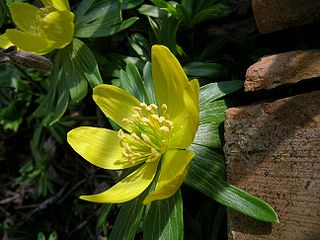
Eranthis is a genus of eight species of flowering plants in the buttercup family Ranunculaceae, native to southern Europe and east across Asia to Japan. The common name winter aconite comes from the early flowering time and the resemblance of the leaves to those of the related genus Aconitum, the true aconite. Like the notoriously toxic AconitumEranthis is poisonous, although its chemistry is different, the toxic compounds present being mainly cardiac glycosides of the bufadienolide group similar to those found in Adonis vernalis, rather than the virulent alkaloids of Aconitum.
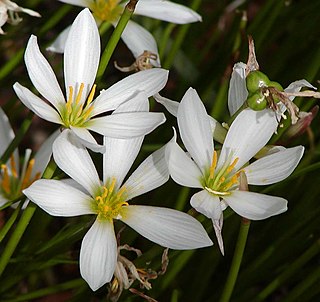
Zephyranthes is a genus of temperate and tropical bulbous plants in the Amaryllis family, subfamily Amaryllidoideae, native to the Americas and widely cultivated as ornamentals. Following the expansion of the genus in 2019, which now includes the genera Habranthus and Sprekelia, there are about 200 recognized species, as well as numerous hybrids and cultivars. Common names for species in this genus include fairy lily, rainflower, zephyr lily, magic lily, Atamasco lily, and rain lily.
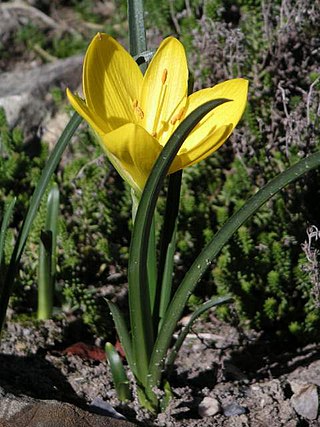
Sternbergia lutea, the winter daffodil, autumn daffodil, fall daffodil, lily-of-the-field, or yellow autumn crocus, is a bulbous flowering plant in the family Amaryllidaceae, subfamily Amaryllidoideae, in the Narcisseae tribe, which is used as an ornamental plant. It has yellow flowers which appear in autumn.

Zephyranthes robusta, synonym Habranthus robustus, commonly known as the Brazilian copperlily, pink fairy lily or the pink rain lily, is a species of herbaceous flowering bulb. It is native to Brazil, Argentina and Uruguay, but is now naturalized in Florida, Colombia, South Africa, and Mauritius.

Sternbergia is a genus of Eurasian and North African plants in the Amaryllis family, subfamily Amaryllidoideae.

Lycoris radiata, known as the red spider lily, red magic lily, corpse flower, or equinox flower, is a plant in the amaryllis family, Amaryllidaceae, subfamily Amaryllidoideae. Originally from China, Japan, Korea and Nepal and from there to the United States and elsewhere. It is considered naturalized in Seychelles and in the Ryukyu Islands. It flowers in the late summer or autumn, often in response to heavy rainfall. The common name hurricane lily refers to this characteristic, as do other common names, such as resurrection lily; these may be used for the genus as a whole.

Ornamental bulbous plants, often called ornamental bulbs or just bulbs in gardening and horticulture, are herbaceous perennials grown for ornamental purposes, which have underground or near ground storage organs. Botanists distinguish between true bulbs, corms, rhizomes, tubers and tuberous roots, any of which may be termed "bulbs" in horticulture. Bulb species usually lose their upper parts during adverse conditions such as summer drought and heat or winter cold. The bulb's storage organs contain moisture and nutrients that are used to survive these adverse conditions in a dormant state. When conditions become favourable the reserves sustain a new growth cycle. In addition, bulbs permit vegetative or asexual multiplication in these species. Ornamental bulbs are used in parks and gardens and as cut flowers.
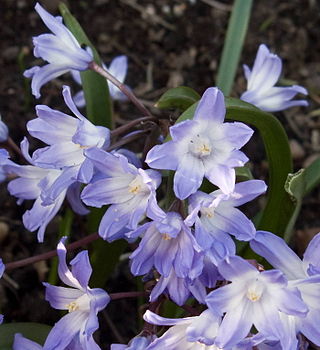
Scilla forbesii, known as Forbes' glory-of-the-snow, is a bulbous perennial plant from west Turkey flowering in early spring. It is considered synonymous with Scilla siehei, known as Siehe's glory-of-the-snow, by some sources, although others distinguish them. It belongs to a group of Scilla species that were formerly put in a separate genus, Chionodoxa, and may now be treated as Scilla sect. Chionodoxa. After flowering, it goes into dormancy until the next spring. It seeds readily to form colonies.

Scilla sardensis, the lesser glory-of-the-snow, is a bulbous perennial from west Turkey flowering in early spring. After flowering, it goes into dormancy until the next spring. It belongs to a group of Scilla species that were formerly put in a separate genus, Chionodoxa, and may now be treated as Scilla sect. Chionodoxa.

Sternbergia clusiana is a bulbous flowering plant in the family Amaryllidaceae, subfamily Amaryllidoideae, which is sometimes used as an ornamental plant. It has greenish-yellow flowers which appear in autumn.

Sternbergia colchiciflora is a bulbous flowering plant in the family Amaryllidaceae, subfamily Amaryllidoideae, which is sometimes used as an ornamental plant. The species is native to southern Europe from Spain to Ukraine, as well as from Morocco, Algeria, Turkey, Syria, Lebanon, Palestine, Iran and the Caucasus. It has yellow flowers which appear in autumn.
Sternbergia pulchella is a bulbous flowering plant in the family Amaryllidaceae, subfamily Amaryllidoideae. It has yellow flowers which appear in autumn. The species is native to Syria and Lebanon.
Sternbergia vernalis is a bulbous flowering plant in the family Amaryllidaceae, subfamily Amaryllidoideae, which is sometimes used as an ornamental plant. It has yellow flowers which appear in spring. The species is native to central and southwestern Asia.
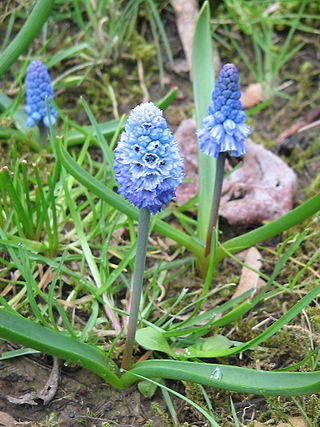
Pseudomuscari azureum, the azure grape hyacinth, is a species of flowering plant in the family Asparagaceae, native to Turkey. A bulbous perennial, it is grown in gardens for its spring flowers. The Latin specific epithet azureum means "bright blue", a reference to its flower colour.

Leucojum aestivum, commonly called summer snowflake or Loddon lily, is a plant species widely cultivated as an ornamental. It is native to most of Europe from Spain and Ireland to Ukraine, with the exception of Scandinavia, Russia, Belarus and the Baltic countries. It is also considered native to Turkey, Iran and the Caucasus. It is naturalized in Denmark, South Australia, New South Wales, Nova Scotia and much of the eastern United States.
Iris purpureobractea is a plant species in the genus Iris, it is also in the subgenus Iris. It is a rhizomatous perennial, from the cliffs and forest glades on the mountains of Turkey. It has straight or falcate shaped leaves, stem with several branches, the stem has purple spathes, it has up to 8 fragrant flowers, in various colours between yellow or blue. It is cultivated as an ornamental plant in temperate regions.
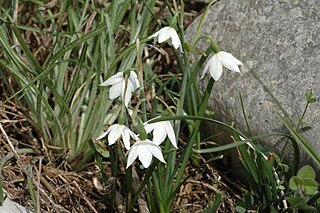
Acis nicaeensis, sometimes called the French snowflake, is a species of flowering plant in the family Amaryllidaceae, native to south-eastern France. A small spring flowering bulb with white flowers, it is cultivated as an ornamental plant.

Acis trichophylla is a species of flowering plant in the family Amaryllidaceae, native to Portugal, Spain and Morocco. It has very narrow leaves. The flowers are produced in late winter or early spring and are usually white, but sometimes pink-tinged or all pink. The species is cultivated as an ornamental bulb, but requires protection from hard frost.

Galanthus plicatus, the pleated snowdrop, is a species of flowering plant in the family Amaryllidaceae, native to eastern Europe and western Asia. It is a spring flowering bulbous herbaceous perennial.
















